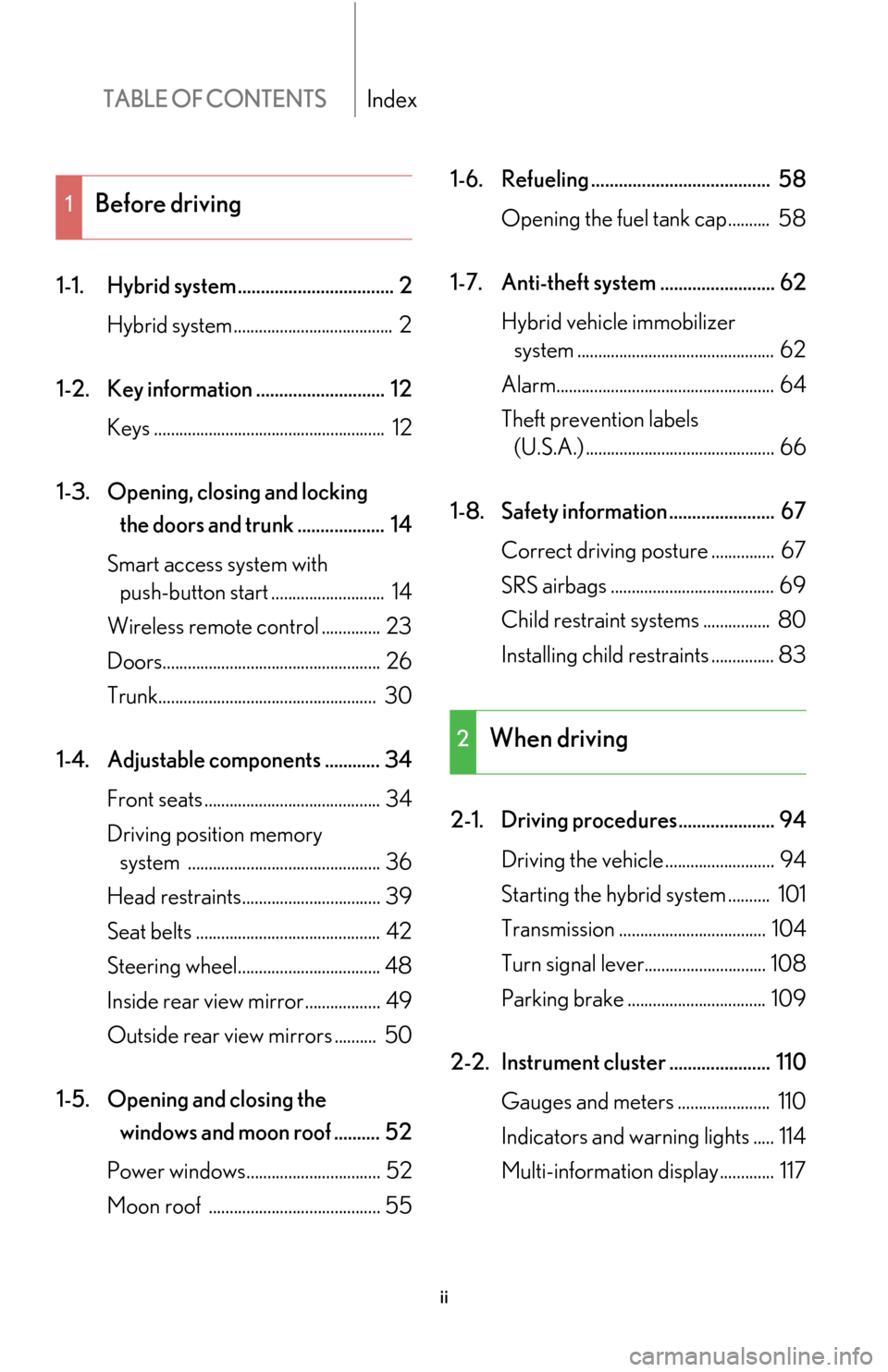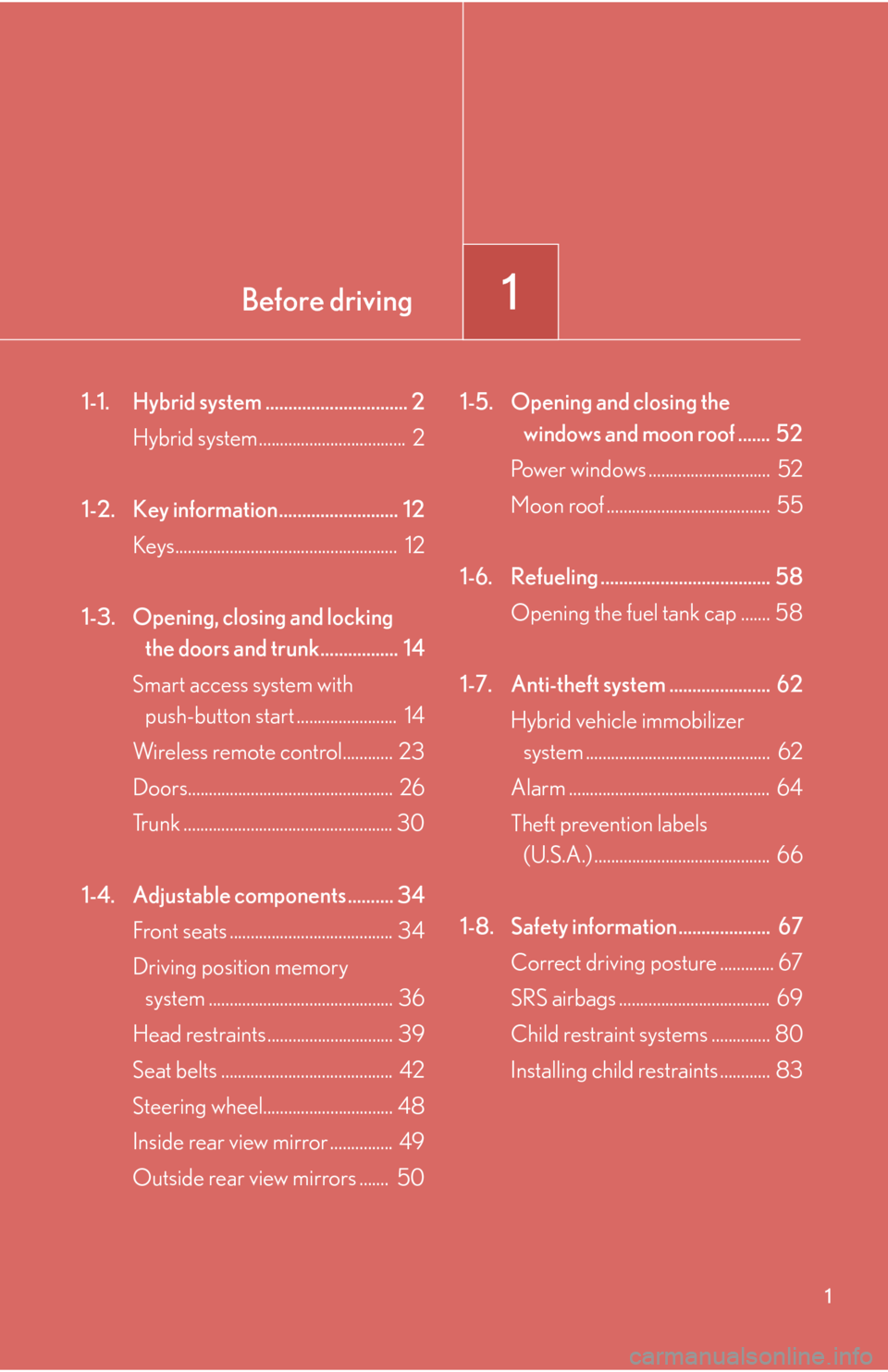seats Lexus GS450h 2007 Using the hands-free system (for cellular phone) / LEXUS 2007 GS450H THROUGH JUNE 2006 PROD. OWNER'S MANUAL (OM30727U)
[x] Cancel search | Manufacturer: LEXUS, Model Year: 2007, Model line: GS450h, Model: Lexus GS450h 2007Pages: 540, PDF Size: 17.11 MB
Page 2 of 540

TABLE OF CONTENTSIndex
ii
1-1. Hybrid system .................................. 2Hybrid system ...................................... 2
1-2. Key information ............................ 12 Keys ....................................................... 12
1-3. Opening, closing and locking
the doors and trunk ................... 14
Smart access system with push-button start ........................... 14
Wireless remote control .............. 23
Doors.................................................... 26
Trunk.................................................... 30
1-4. Adjustable components ............ 34 Front seats .......................................... 34
Driving position memory
system .............................................. 36
Head restraints................................. 39
Seat belts ............................................ 42
Steering wheel.................................. 48
Inside rear view mirror.................. 49
Outside rear view mirrors .......... 50
1-5. Opening and closing the
windows and moon roof .......... 52
Power windows................................ 52
Moon roof ......................................... 55 1-6. Refueling ....................................... 58
Opening the fuel tank cap.......... 58
1-7. Anti-theft system ......................... 62 Hybrid vehicle immobilizer
system ............................................... 62
Alarm.................................................... 64
Theft prevention labels
(U.S.A.) ............................................. 66
1-8. Safety information ....................... 67 Correct driving posture ............... 67
SRS airbags ....................................... 69
Child restraint sy stems ................ 80
Installing child restraints ............... 83
2-1. Driving procedures..................... 94 Driving the vehicle .......................... 94
Starting the hybrid system .......... 101
Transmission ................................... 104
Turn signal lever............................. 108
Parking brake ................................. 109
2-2. Instrument cluster ...................... 110 Gauges and meters ...................... 110
Indicators and warning lights ..... 114
Multi-information display............. 117
1Before driving
2When driving
Page 21 of 540

Before driving1
1
1-1. Hybrid system ............................... 2Hybrid system ................................... 2
1-2. Key information.......................... 12 Keys..................................................... 12
1-3. Opening, closing and locking
the doors and trunk................. 14
Smart access system with
push-button start ........................ 14
Wireless remote control............ 23
Doors................................................. 26
Trunk .................................................. 30
1-4. Adjustable components .......... 34 Front seats ....................................... 34
Driving position memory
system ............................................ 36
Head restraints.............................. 39
Seat belts ......................................... 42
Steering wheel............................... 48
Inside rear view mirror ............... 49
Outside rear view mirrors ....... 50 1-5. Opening and closing the
windows and moon roof ....... 52
Power windows ............................. 52
Moon roof ....................................... 55
1-6. Refueling ..................................... 58 Opening the fuel tank cap ....... 58
1-7. Anti-theft system ...................... 62 Hybrid vehicle immobilizer
system ............................................ 62
Alarm ................................................ 64
Theft prevention labels
(U.S.A.) .......................................... 66
1-8. Safety information .................... 67 Correct driving posture ............. 67
SRS airbags .................................... 69
Child restraint systems .............. 80
Installing child restraints ............ 83
Page 54 of 540

34
1-4. Adjustable components
Front seats
Seat position fore/aft control switch
For driver’s seat only: Height of the head restraint also moves upward or
downward with the seat movement.
Seatback angle control switch
Seat cushion (front) angle control switch
Vertical height control switch
Lumbar support control switch
Page 59 of 540

39
1
1-4. Adjustable components
Before driving
Head restraints
■Vertical adjustment
Driver’s seat
Head restraint height can be
adjusted automatically along
with the seat position adjust-
ment. ( P. 3 4)
Front passenger’s and rear seats Grip head restraint and move
it up or down.
Push and hold the lock release
button when lowering the head
restraint.
Grip head restraint and
remove while holding the
lock r
elease button.
■ Horiz
ontal adjustment
Front and outboard rear seats
Grip head restraint and twist to
tilt for
ward or backward.
Lock
release
button
Page 60 of 540

40
1-4. Adjustable components
■Adjusting the height of the driver’s head restraint manually
■Removing the driver’s seat head restraint
For removal and installation, ask
your Lexus dealer.
■Adjusting the height of the head restraints
■Adjusting the center rear seat head restraint
Always raise the head restraint one level from the stowed position when using.
■Head restraints of different seats
The head restraints are specially designed for the seats on which they are installed.
Push and hold the lock release button when
lowering or raising the head restraint.
Make sure that the head restraints are
adjusted so that the center of the head
restraint is closest to the top of your ears.
Page 63 of 540

43
1-4. Adjustable components
1
Before driving
Seat belt comfort guide (outboard rear seats)
If the shoulder belt fits close to a
person’s neck, slide the seat belt
comfort guide forward.
Seat belt pretensioners (front and outboard rear seats)
The pretensioner helps the seat
belt to quickly restrain the occu-
pant by retracting the seat belt
when the v
ehicle is subjected to
certain types of severe frontal colli -
sion.
The pretensioner may not activate
in the event of a minor frontal
impact, a side impact or a rear
impact.
■ Adjusting the height of the belt (front seats)
Up
Down
Move the height adjuster up and
down as needed until you hear a
click.
Page 64 of 540

44
1-4. Adjustable components
Pre-collision seat belts (front seats of vehicles with pre-collision system)
When the pre-collision sensor detects an obstacle and determines that a
collision is unavoidable, the seat belts lessen collision injury by retracting
the slack in the front seat belts befo re the collision, thus restraining the
driver and passenger at an earlier stage.
The seat belts will also operate in the event of sudden braking. ( P. 1 6 7 )
■Emergency locking retractor (ELR)
The retractor will lock the belt during a sudd e
n stop or on impact. It may also lock if
you lean forward too quickly. A slow, easy motion will allow the belt to extend, and
you can move around fully.
■Automatic locking retractor (ALR)
When a passenger's shoulder bel
t is completely extended and then retracted even
slightly, the belt is locked in that position and cannot be extended. This feature is
used to hold the child restraint system (CRS) firmly. To free the belt again, fully
retract the belt and then pull the belt out once more. ( P. 8 7 )
■Pregnant women
Obtain medical advice and wear the seat belt
in the proper way. ( P. 4 2 )
Women who are pregnant should position
the lap belt as low as possible over the hips in
the same manner as other occupants. Extend
the shoulder belt completely over the shoul-
der and position the belt across the chest.
Avoid belt contact over the rounding of the
abdominal area.
If the seat belt is not worn properly, not only a
pregnant woman, but also the fetus could suf-
fer death or serious injury as a result of sud-
den braking or a collision.
Page 66 of 540

46
1-4. Adjustable components
CAUTION
■Wearing a seat belt
Observe the following precautions to reduce the risk of injury in the event of sud-
den braking or an accident. Failing to do so may cause death or serious injury.
●Ensure that all passengers wear a seat belt.
●Always wear a seat belt properly.
●Each seat belt should be used by one person only. Do not use a seat belt for more
than one person at the same time, including children.
●Children should be seated in the rear se at and always use a seat belt and/or an
appropriate child restraint system.
●Do not recline the seat any more than necessary to achieve a proper seating
position. The seat belt is most effective when the occupants are sitting up straight
and well back in the seats.
●Do not wear the shoulder belt under your arm.
●Always wear your seat belt low and snug across your hips.
■Seat belt damage and wear
●Do not damage the seat belts by allowing the belt, plate or buckle to be jammed
in the door.
●Inspect the seat belt system periodically. Check for cuts, fraying, and loose parts.
Do not use a damaged seat belt until it is replaced. Damaged seat belts cannot
protect an occupant from injury.
●Ensure that the belt and tab are locked and the belt is not twisted. If the seat belt
does not function correctly, immediately contact your Lexus dealer.
●Replace the seat assembly, including the belt s, if your vehicle has been involved in
a serious accident, even if there is no obvious damage.
●Do not attempt to install, remove, modify , disassemble or dispose of a seat belt.
Have any necessary repairs carried out by your Lexus dealer. Inappropriate han-
dling of the pretensioner may cause it to activate or operate improperly and may
cause death or serious injury.
Page 88 of 540

68
1-8. Safety information
CAUTION
■Caution while driving
●Do not adjust the position of the driver’s seat.
Doing so could cause the driver to lose control of the vehicle.
●Do not place a cushion between the driver or passenger and the seatback.
A cushion may prevent correct posture from being achieved, and reduce the
effectiveness of the seat belt and head re straint, increasing the risk of death or
serious injury to the driver or passenger.
●Do not place anything under the front seats.
Objects placed under the front seats may become jammed in the seat tracks and
stop the seat from locking in place. This may lead to an accident. The adjustment
mechanism may also be damaged.
■Adjusting the seat position
●Do not recline the seat more than necessary when the vehicle is in motion, to
reduce the risk of slid ing under the lap belt.
If the seat is too reclined during an accident, the lap belt may slide past the hips
and apply restraint forces directly to th e abdomen or your neck may contact the
shoulder belt, increasing the ri sk of death or serious injury.
●Take care when adjusting the seat position to ensure that other passengers are
not injured by the moving seat.
●Do not put your hands under the seat or near the moving parts to avoid injury.
Fingers or hands may become jammed in the seat mechanism.
Page 91 of 540

71
1-8. Safety information
1
Before driving
In certain types of severe frontal or side impacts, the SRS airbag system
triggers the airbag inflators. A chemica l reaction in the inflators quickly
fills the airbags with non-toxic gas to help restrain the motion of the occu -
pants.
■If the SRS airbags deploy (inflate)
●Bruising and slight abrasions may result from contact with a deploying (inflating)
SRS airbag.
●A loud noise and white powder will be emitted.
●Parts of the airbag module (steering wheel hub, airbag cover and inflator) as
well as the front seats, and parts of the front pillar and roof side rail, may be hot
for several minutes. The airbag itself may also be hot.
●The windshield may crack.
■Operating conditions (front airbags)
●The SRS front airbags will deploy if the severity of the frontal impact is above the
designed threshold level, comparable to an approximate 15 mph (25 km/h) col -
lision in the U.S.A. and 18 mph (30 km/h) collision in Canada when the vehicle
impact
s straight into a fixed barrier that does not move or deform.
However, this threshold velocity will be considerably higher if the vehicle strikes
a
n object, such as a parked vehicle or sign pole, which can move or deform on
impact, or if the vehicle is involved in an underride collision (e.g. a collision in
which the front of the vehicle “underrides”, or goes under, the bed of a truck, etc.).
●It is possible that in some collisions where the forward deceleration of the vehi -
cle is very close to the designed thresh ol
d level, the SRS front airbags and the
seat belt pretensioners ma y not activate together.
●The SRS front passenger airbag will not activate, if there is not passenger sitting
in the front passenger seat. However, th e front passenger airbag may deploy, if
luggage is put in the seat or the seat belt is buckled up, regardless of the pres -
ence of an occupant in the seat.